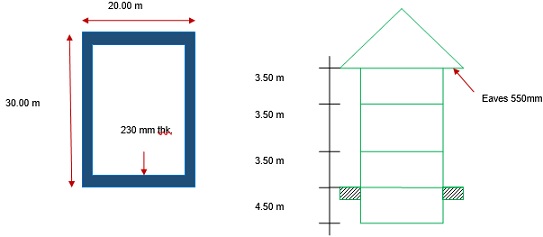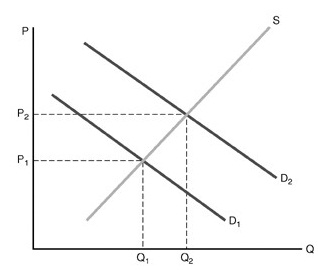Q1. The steeper the slope of the production function, the less is the marginal physical product of labor.
a. true
b. false
Q2. When marginal physical product begins to decline, marginal cost begins to increase.
a. true
b. false
Q3. Table 5.6
|
Quantity
|
Total Cost
|
|
0
|
90
|
|
1
|
115
|
|
2
|
122
|
|
3
|
132
|
|
4
|
154
|
|
5
|
185
|
Refer to Table 5.6. What is the marginal cost of producing the third unit?
a. 25
b. 115
c. 90
d. 10
Q4. It is possible for a firm to have positive fixed cost and zero total cost.
a. true
b. false
Q5. Table 5.3
|
Quantity of Workers
|
Total Product
|
Average Physical Product
|
Marginal Physical Product
|
|
0
|
0
|
|
|
|
1
|
3
|
|
|
|
2
|
7
|
|
|
|
3
|
12
|
|
|
|
4
|
16
|
|
|
|
5
|
18
|
|
|
|
6
|
18
|
|
|
In Table 5.3, the average physical product of the 3rd worker is
a. 3.
b. 12.
c. 5.
d. 4.
Q6. The shape of a firm's production function will change if the productivity of its variable input changes.
a. true
b. false
Q7. Which one of the following is TRUE?
a. Marginal cost increases as marginal physical product decreases.
b. Marginal cost decreases as marginal product decreases.
c. Total cost is the difference between marginal cost and total variable cost.
d. Total cost is the sum of marginal cost plus total variable cost.
Q8. Table 5.7
|
Q
|
Total Variable Cost
|
Average Variable Cost
|
Total Cost
|
Average Total Cost
|
|
1
|
10
|
|
50
|
|
|
2
|
50
|
|
90
|
|
|
3
|
|
|
|
40
|
Refer to Table 5.7. What is the average variable cost of producing two units?
a. 25
b. 10
c. 50
d. Not enough information is provided.
Q9. Table 5.4
|
Quantity of Labor
|
Total Product
|
Average Product
|
Marginal Product
|
|
1
|
|
220
|
|
|
2
|
|
335
|
|
|
3
|
|
|
338
|
|
4
|
|
|
320
|
Refer to Table 5.4. What does total product equal when 2 units of labor are used?
a. 320
b. 350
c. 335
d. 670
Q10. Table 5.7
|
Q
|
Total Variable Cost
|
Average Variable Cost
|
Total Cost
|
Average Total Cost
|
|
1
|
10
|
|
50
|
|
|
2
|
50
|
|
90
|
|
|
3
|
|
|
|
40
|
Refer to Table 5.7. What is the firm's total fixed cost?
a. 20
b. 40
c. 10
d. 30
Q11. The market structure of perfect competition is defined by hundreds of firms producing an essential product, with barriers to the entry of new firms.
a. true
b. false
Q12. The firm in a perfectly competitive industry is a
a. price seeker.
b. price maker.
c. price taker.
d. price dealer.
Q13. A single supplier of a good or service for which there is no close substitute is referred to as a(n)
a. monopolistic competitor.
b. strategic competitor.
c. monopoly.
d. oligopoly.
Q14. Which of the following is closest to a perfectly competitive market?
a. computer software
b. athletic shoes
c. wheat
d. handmade guitars
Q15. When there are economic profits in a perfectly competitive industry
a. firms have no incentive to exit or enter the industry.
b. firms exit the industry.
c. firms enter the industry.
d. the high barriers to entry prevent further competition.
Q16. In perfect competition, the larger firms will be able to charge a higher price than the smaller firms.
a. true
b. false
Q17. The profit maximizing level of production
a. is not measurable for a perfectly competitive firm.
b. is where the difference between marginal revenue and marginal cost is maximized.
c. ignores the relation of total revenues and total costs.
d. is the quantity at which marginal revenue equals marginal cost.
Q18. For the perfectly competitive firm, price equals marginal revenue.
a. true
b. false
Q19. For a monopolist, selling more units requires
a. allowing more firms to enter the industry.
b. hiring a more productive labor force.
c. forming a cartel.
d. lowering the selling price.
Q20. Which of the following is true of a perfectly competitive firm and a monopoly in the long run?
a. P = ATC
b. P = MC
c. P = MR
d. MR = MC
Q21. To the extent that a firm has market power, it can force its competitors out of business.
a. true
b. false
Q22. Which of the following is a characteristic of both perfect competition and monopolistic competition?
a. In the long run, the firm will produce the output which minimizes average total cost.
b. Firms sell a homogeneous product.
c. In the long run, the firm will earn zero economic profit.
d. The firm seeks to differentiate its product from those of its competitors.
Q23. In monopolistic competition
a. price equals marginal revenue for all levels of output.
b. price is greater than marginal revenue for all levels of output except for the first unit.
c. price is less than marginal revenue for all levels of output.
d. the demand curve is perfectly inelastic and marginal revenue is zero.
Q24. Price leadership is a form of
a. barrier to entry.
b. tacit collusion.
c. opportunistic behavior.
d. noncooperative behavior.
Q25. Opportunistic behavior is discouraged by the desire to have repeat transactions.
a. true
b. false
Q26. The industry of fine art auction houses is
a. a monopoly.
b. monopolistically competitive.
c. a duopoly.
d. perfectly competitive.
Q27. Signaling occurs as part of
a. noncooperative behavior.
b. advertising.
c. price leadership.
d. opportunistic behavior.
Q28. The monopolistic competitor depicted below would find that which of the following is INCORRECT?

Figure
a. The profit maximizing rate of output is indicated by E, where MR intersects MC.
b. The demand curve shows that the firm faces a perfectly elastic demand.
c. The profit-maximizing rate of output is qe, and the profit maximizing price is P.
d. A downward sloping marginal revenue curve lies below the demand curve.
Q29. A monopolistically competitive firm in the long run
a. earns positive economic profits.
b. earns negative economic profits.
c. earns zero economic profits.
d. suffers economic losses.
Q30. A monopolistically competitive firm uses advertising to
a. lower its costs.
b. differentiate its product.
c. signal its competitors that it is serious about staying in business.
d. motivate its work force.
Q31. In a progressive tax system, the marginal tax rate increases as income increases.
a. true
b. false
Q32. Antitrust legislation seeks to correct market failure by ensuring that all firms in the industry earn an economic profit.
a. true
b. false
Q33. Markets tend to underallocate resources to the production of a good when
a. there are negative externalities.
b. equilibrium occurs.
c. there are positive externalities.
d. there are public goods produced.
Q34. The problem of positive externalities can be addressed by having some firms exit the industry.
a. true
b. false
Q35. Which one of the following is TRUE?
a. Private goods are subject to the principle of rival consumption.
b. Public goods are those that generate positive externalities.
c. Public goods are a subset of private goods.
d. Private goods are produced for a local market; public goods are produced for a national market.
Q36. Licensing requirements for taxis mean that taxi fares are higher than they otherwise would be.
a. true
b. false
Q37.

Figure
Refer to Figure 8.2. The market equilibrium is Q1. Point Q2 represents the optimal point of production. To reach Q2,
a. consumption of the good could be taxed.
b. a subsidy could be given to consumers.
c. production of the good could be taxed.
d. the industry producing the good should operate as a cartel.
Q38. If your marginal tax rate is always higher than your average tax rate, then the tax system is a
a. proportional tax system.
b. regressive tax system.
c. fair tax system.
d. progressive tax system.
Q39. Private goods are characterized by the principle of rival consumption.
a. true
b. false
Q40. A tax system is which the marginal tax rate falls as more income is earned is
a. proportional.
b. progressive.
c. flat-rate.
d. regressive.
Q41. An increase in the selling price of a product
a. increases the supply of labor to the industry.
b. increases the productivity of labor.
c. raises the firm's demand for labor.
d. decreases the supply of labor to the industry.
Q42. Collective bargaining is the process by which unions and employers negotiate the conditions of employment and wages.
a. true
b. false
Q43. When MFC = MRP, a firm in a competitive market will
a. hire more workers.
b. stop hiring.
c. layoff workers.
d. earn additional profits.
Q44. Economists Freeman and Medoff argue that unions have harmed the economy by making the workforce less productive.
a. true
b. false
Q45. The supply of labor to the health care industry will decrease when
a. working conditions for health care workers improve through legislated mandates.
b. minimum wages are legislated for health care workers.
c. workers receive better employment opportunities in other industries.
d. there is an increased demand for health care.
Q46. If unions succeed at restricting the supply of labor in any one area of the economy, wages in that sector will increase.
a. true
b. false
Q47. Increases in the minimum wage increase unemployment among unskilled workers.
a. true
b. false
Q48. If labor productivity increases,
a. the supply of labor will increase.
b. the supply of labor will decrease.
c. workers will earn wages higher than their marginal revenue product.
d. the demand for labor will increase.
Q49. The fact that the labor supply curve slopes upward indicates that
a. workers seek to work more hours when the wage rises.
b. the income effect of a wage increases outweighs the substitution effect.
c. workers seek to work more hours when the wage decreases.
d. firms want to hire more workers when the wage rises.
Q50. A firm's marginal revenue product of labor curve is also
a. its labor demand curve.
b. its total revenue line.
c. its long-run input cost function.
d. its marginal cost curve.